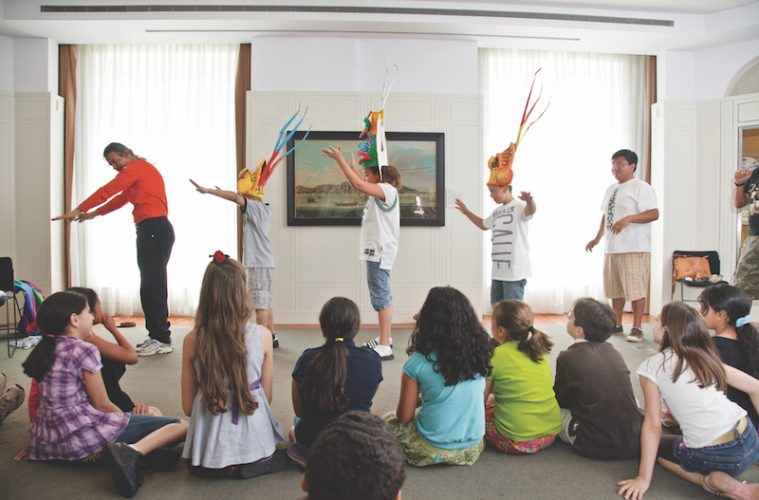“Kids are inherently creative. I believe that in my soul,” says Gavin Andrews, deputy chief of education and interpretation at the Peabody Essex Museum (PEM) in Salem.
This inherent creativity is what is explored in Creative Collaborations, an ongoing program at PEM for participating schools from Salem and Lynn. Like many art museums around the country, PEM fills a niche for low-resource schools in ways people like art teacher Mary Parks from Harrington Elementary in Lynn find invaluable.
For instance, one project begins with students studying portraits at PEM from colonial and Puritan times. They then look at themselves in a mirror and think about shape, space, and color. The background is filled with words that the students choose to describe themselves. After they draw their portrait, Parks teaches them how to mix skin tone with watercolors. Sometimes students create a second portrait later in the school year, demonstrating how their artistic technique and their perception of themselves have evolved. “I’m always amazed at the results,” says Parks. “The artwork is truly a reflection of the diverse group of students we have at Harrington.”
Funded in large part by the Calderwood Charitable Foundation, the program provides fully subsidized museum visits, covering the costs of transportation, program fees, and supplies. Teachers from PEM also make visits to schools to discuss ways of looking at and discussing museum objects.
“The staff leaves me with a container filled with enough materials for every third grader to practice writing a colonial alphabet with real quill feather pens, the ink that was used in the colonial times, and parchment paper so students can write their names,” says Parks. “The students absolutely love this activity. They are amazed at how hard it is to write with these materials.”
Students make personal connections with works of art and connect what they learn at the museum with their social studies and language arts curriculum. At a Family Night celebration in the spring at PEM, students present their final projects. What Andrews loves is the program’s ability to foster critical and creative thinking skills. “Students develop language and communication skills just by making observations about an object,” she says. “We help provide a toolbox for expression.”
Creative Collaborations began a decade ago, after PEM embarked on a rigorous multiyear evaluation that involved stakeholders, including students and teachers. “We offer them inspiration, but I’m equally inspired by the teachers and their ideas,” says Andrews.
At Bates Elementary in Salem, museum personnel, classroom teachers from grades 3 to 5, and art teacher Todd Bleckley gather at the beginning of each school year to discuss PEM’s current and upcoming exhibitions and to tailor a program for each grade level. Last school year, Bleckley helped students create their own answer to Pakistani artist Anila Agha’s Intersections, an immersive installation with traditional Islamic architectural motifs, meant to welcome all genders and religions while bathing the viewer in a glowing geometric light. The project was a hit at the annual art show, says Bleckley, which also featured a special “Museum Connections” gallery.
Harrington librarian Carol Shutzer loves the annual visit to PEM’s 17th-century John Ward House, after which third graders create a diagram comparing and contrasting the historic house to their own homes. “Of course, reading about a Puritan home in a textbook is helpful,” says Shutzer, “but actually walking into the Ward House and ‘seeing’ the rooms, the fireplace, the large Bible, and the beds in the living room truly cements this information.”
Fourth graders read Chinese folktales and then compare and contrast the Yin Yu Tang Chinese house with the Federal style of the Gardiner-Pingree House, as well as comparing the lives of the inhabitants.
Creative Collaborations can be uniquely tailored for individual classes, but is designed for three museum visits. When that schedule didn’t work for Harrington Elementary, PEM worked with the school to help build a curriculum that would carry over from the museum to the classroom and integrated museum visits into school projects. “This enables the students to have three or more classes devoted to the Creative Collaborations program in a manner that fits our school,” says Shutzer. “The PEM collaboration has become an integral part of the school year.”
Peabody Essex Museum?
161 Essex St., Salem
978-745-9500

